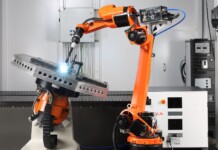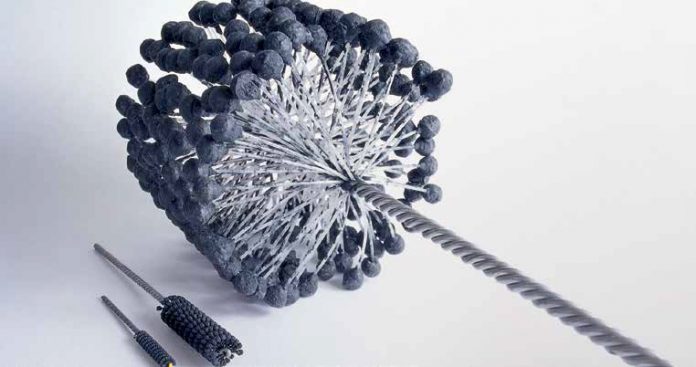Until recently, the surface finishing of small cylindrical surfaces composed of hard metals, ceramics and other tough materials has required the use of expensive and often cumbersome equipment such as micro-finishing anvils or diamond turning tools.
For those that manufacture or repair products with small cylindrical components or cavities, surface finishing operations such as deburring, edge blending, and achieving a “near mirror” finish can now be performed with a highly efficient and flexible new tool – the diamond flex-hone.
The diamond flex-hone is a brush-type hone that has diamond crystals bonded to flexible filaments enabling finishing of cylindrical surfaces of hard materials used in aerospace, medical, scientific and industrial applications to a Ra of 0.5µm.
This means that parts such as carbide bushings, bore sleeves, hydraulic and pneumatic cylinders, as well as cylindrical cavities can be can surface finished on the production line or resurfaced in the field using a relatively inexpensive tool that requires very little setup time.
Featuring diamond crystal laminated onto flexible nylon filaments, the diamond flex-hone can be used with hand drill motors, drill presses or other spindles to surface finish or repair blemishes in any cylinder from 4 mm up to 38 mm in diameter (custom sizes are also available). A range of diamond grit sizes is available that can be used in combination for progressive finishing operations.
Typical cylindrical applications include carbide wear parts, optical glass, ceramic cylinders, heat-treated steel, high nickel stainless steel, MMX aluminum alloys, chromed and plated bores.
While such applications are included in many large business sectors, they are also present in smaller, more specialized sectors, such as instrumentation, where the precision manufacture and maintenance of cylinders are particularly critical.
Accuracy to a Micron
“While we provide expert instrument calibration services, we also repair instruments that require precise machining, sometimes up to a micron,” explains Lucas Stuhr, manager of hand tools at Fox Valley Metrology (FVM), headquartered in Oshkosh, WI. “We were looking for a method of providing quicker service on instruments include handheld devices such as micrometers, calipers and bore gages – all of which are needed for making precision equipment.”
The policy of FVM is to provide the highest level of quality service with minimal economic impact on its customers. This includes fast turnaround time, affordable prices, personalized service, and even training customers on the servicing of their own equipment.
“All of the handheld instruments are subject to wear and tear,” Stuhr explains, “If any of them develops an imperfection, such as a burr or scratch in a crevice or cylinder, we want to have the right tool available to correct that imperfection.”
To provide quick turnaround service, Stuhr decided to try a new honing technology he discovered in an Internet search, the Diamond Flex-Hone from Brush Research Manufacturing (Los Angeles, CA).
Brush Research is the developer of the flexible hone technology used for a wide variety of finishing applications throughout industry. Known as the Flex-Hone or ball-style hone, this tool is available in a variety of grit materials and is very popular throughout industry for deburring, edge blending and surface finishing.
The Diamond Flex-Hone tool looked promising to Stuhr for the resurfacing of the sleeves used in the cylindrical bores of hand gages. Removing scratches, burrs or other protrusions typically required the use of flux and a small diamond anvil turned against the sleeve. Use of the anvil tool often required taking the gage back to the FVM shop, which meant the gage could be out of service for days at a time.
Using the diamond flex-hone, the FVM technicians are now quickly re-honing holes on site, Stuhr explains. “This is a much cheaper and quicker process than using a high-end machine tool that can cost as much as $10,000 – $15,000 per unit,” he says. “We can usually do the work at the customer’s site. Plus, the diamond flex-hone sometimes enables us to extend the service life of the sleeves we service. That is extremely valuable to customers because replacement parts often come from Asia and Europe, and it usually takes weeks to replace them.”
Stuhr says the diamond flex-hone can handle “any materials we throw at it”. Clearing out burrs and high spots from a cylindrical surface now takes only seconds. Because the hone is self-centering, a hand-held drill motor is providing the accuracy of much more expensive tools that require constant alignment. Although he sometimes deals with brass sleeves, his department also uses the new tool to resurface hard steel and carbide.
Stuhr adds that the diamond flex-hone is so affordable and easy to use that his technicians are now training customers how to use it for deburring and other resurfacing operations, saving them additional time and money.
Achieving extreme stability
In a more unusual application, the diamond flexible hone is undergoing testing for use in finishing the cylindrical surface of holes bored in large mirrors used with a telescope system at the Keck Observatory at Mauna Kea, Hawaii.
Telescopes such as Keck’s track objects, sometimes for hours, across the sky as the Earth turns. This resulting constant, but subtle, movement results in slight deformations of the telescope structure. In addition to extreme stability requirements, computer-controlled corrections to the primary mirror are necessary for scientific observations.
Engineers at Keck Observatory are currently working on a project that involves heavy optical glass mirrors drilled with holes in order to bond attachments to the glass. The team has been investigating different methods to prepare the glass by removing subsurface damage that normally occurs while machining the holes.
“This is a complex application,” explains Dennis McBride, Principal Engineer, Operations & Infrastructure Department. “A diamond tool is required when grinding or finishing holes bored in glass.”
McBride’s team is testing the Brush Research Diamond Flex-Hone to smooth away subsurface damage to the holes after machining. The was tested by attaching it to a drill press and surface finishing holes ground into test glass similar to the telescope mirrors.
“Tools such as a CNC Machine or a core drill require that you perfectly line up with the holes,” explains McBride. “However, the diamond flex-hone is advantageous because it is flexible and self-centering, so it doesn’t require that you have a perfect alignment to the holes. So, they are faster, easier, and work very well.”
McBride adds that testing is ongoing, “But we have a very favorable opinion of the diamond flex-hone, and it is likely to be used somewhere in the process.”
Brush Research Mfg. Co., Inc.
4642 East Floral Drive
Los Angeles, CA 90022
P: (323) 261-2193
F: (323) 268-6587



















